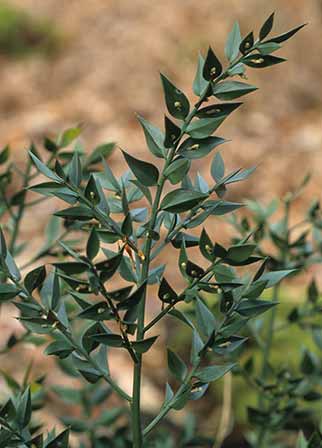Butcher’s broom (Ruscus aculeatus)
When: All year round
How many: Relatively widespread and quite numerous

Butcher’s broom is an unmistakable plant that is also one of the most unusual to be found in the New Forest. It is widespread in many of New Forest woodlands, but rarely abundant.
Butcher’s broom is an evergreen, a stiffly upright, prickly member of the lily family that can grow to a height of around 90 centimetres (3 feet), and sometimes occurs in clumps up to 150 centimetres (5 feet) wide.
What appear to be oval, dark green, rigid, sharp-spined butcher’s broom leaves are really flattened stems or branches, and it is from the middle of these that tiny, inconspicuous, whitish-green, 6-petalled flowers appear from January to April, often alongside globe-shaped, bright red berries from the previous year.
To some extent browse resistant, in the New Forest, butcher’s broom is only sparingly taken by commoners’ stock, and deer, for its foliage is not easily eaten. In fact, so rigid are the stems that by tradition they were tied in bundles and used to sweep butcher’s blocks, a practice which gave the plant its name.
In 1657, William Coles in Adam in Eden suggested as much, saying of butcher’s broom: ‘now it is used by few unless it be Butchers who make cleane their stalls, and defend their meat from the flyes therewith.’
In parts of Hampshire, though, butcher’s broom was just as appropriately known as knee-holm, a reference to its height and superficial similarity to holly, which was also known as holm. Other related names included knee-holly and knee-hulver – hulver was another old name for holly.
Nicolas Culpeper was something of a butcher’s broom enthusiast. Here’s an extract from Culpeper’s Complete Herbal, and English Physician, first published in 1652.
‘It is a plant of Mars, being of a gallant cleansing and opening quality: the decoction of the roots, made with wine, openeth obstructions, provoketh urine, helpeth to expel gravel, and the stone, the stranguary, and women's courses, as also the yellow jaundice, and the head-ach; and, with some honey or sugar put therein cleanseth the breast of phlegm, and the chest of much clammy humours gathered therein; the decoction of the root drunk, and a poultice made of the berries and leaves being applied, are effectual in knitting and consolidating broken bones, or parts out of joint. The common way of using it, is to boil the root of it and parsley, and fennel, and smallage, in white wine, and drink the decoction, adding the like quantity of grass roots to them; the more of the roots you boil, the stronger will the decoction be; it works no ill effects, yet I hope you have wit enough to give the strongest decoction to the strongest bodies.’
So there!
References:
The Wild Flowers of Britain and Northern Europe: Richard Fitter, Alastair Fitter and Marjorie Blamey
Reader’s Digest Field Guide to the Wild Flowers of Britain
The Englishman’s Flora: Geoffrey Grigson
More links
Other related links
Search this site

Sadly, 58 animals were killed - 35 ponies, 13 cows, 8 donkeys and 2 sheep, whilst a further 32 were injured - 3 pigs, 9 donkeys, 11 cows and 9 ponies.
(Forty-three accidents occurred in daylight, 15 at twilight and 101 in the dark. Twenty-seven accidents were not reported by the driver involved).
Here's just one horrific example - Three donkeys killed in collision with van at notorious New Forest blackspot (Advertiser and Times)

